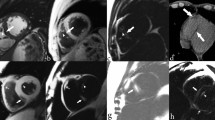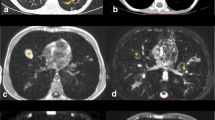Abstract
Background
While reviewing chest CT scans of infants, we repeatedly observed hyperdense enhancing tissue in the chest wall that is not well described in radiology literature.
Objective
This study was undertaken to describe the imaging features of this tissue in chest walls of infants.
Materials and methods
CT scans of the chest conducted on all infants between April 2008 and October 2009 were retrospectively reviewed. CT studies with any deviation from normal radiation or contrast dose or those with chest wall anatomical distortion were excluded.
Results
One hundred eighty-eight infants were scanned, with 202 MDCTs, of which 180 (89.1%) received contrast agent. Fifty-four of 180 (30%) cases revealed focal areas of hyperdensity in various locations. All positive cases ranged between 2 days and 9 months of age. The areas of distribution of hyperdensity had excellent correlation with known areas of brown fat in the chest wall, known from nuclear medicine studies, and hence we concluded these to represent the same.
Conclusion
Brown fat in the chest wall can be seen as enhancing tissue on contrast CT scans done on infants. This is a normal morphological component with the brown fat converting to normal fat. It is important to recognize it in the chest wall of infants to avoid misinterpretation.








Similar content being viewed by others
References
Hatai S (1902) On the presence in human embryos of an interscapular gland corresponding to the so-called hibernating gland of lower mammals. Anat A 21:369–373
Cypess AM, Lehman S, Williams G et al (2009) Identification and importance of brown adipose tissue in adult humans. N Engl J Med 360:1509–1517
Yeung HW, Grewal RK, Gonen M et al (2003) Patterns of (18)F-FDG uptake in adipose tissue and muscle: a potential source of false-positives for PET. J Nucl Med 44:1789–1796
Jadvar H, Connolly LP, Fahey FH et al (2007) PET and PET/CT in pediatric oncology. Semin Nucl Med 37:316–331
Shammas A, Lim R, Charron M (2009) Pediatric FDG PET/CT: physiologic uptake, normal variants, and benign conditions. Radiographics 29:1467–1486
Zukotynski KA, Fahey FH, Laffin S et al (2009) Constant ambient temperature of 24 degrees C significantly reduces FDG uptake by brown adipose tissue in children scanned during the winter. Eur J Nucl Med Mol Imaging 36:602–606
Aherne W, Hull D (1966) Brown adipose tissue and heat production in the newborn infant. J Pathol Bacteriol 91:223–234
Miller SF (2004) Resolution of calcific brown fat necrosis associated with prostaglandin therapy for cyanotic congenital heart disease in neonates: report of two cases. Pediatr Radiol 34:919–923
Stephenson TJ, Variend S (1987) Visceral brown fat necrosis in postperinatal mortality. J Clin Pathol 40:896–900
Heaton JM (1972) The distribution of brown adipose tissue in the human. J Anat 112:35–39
Cohade C, Osman M, Pannu HK et al (2003) Uptake in supraclavicular area fat (“USA-fat”): description on 18F-FDG PET/CT. J Nucl Med 44:170–176
Okuyama C, Ushijima Y, Kubota T et al (2003) 123-I-metaiodobenzylguanidine uptake in the nape of the neck of children: likely visualization of brown adipose tissue. J Nucl Med 44:1421–1425
Fukuchi K, Ono Y, Nakahata Y et al (2003) Visualization of interscapular brown adipose tissue using 99mTc-tetrofosmin in pediatric patients. J Nucl Med 44:1582–1585
George JC, Eapen J (1959) A histological and histochemical study of the brown and yellow adipose tissue of the bat, Hipposideros speoris. Q J Microsc Sci 100(Part3):369–375
Smith RE, Horwitz BA (1969) Brown fat and thermogenesis. Physiol Rev 49(2):330–425
Author information
Authors and Affiliations
Corresponding author
Rights and permissions
About this article
Cite this article
Gupta, P., Babyn, P.S., Shammas, A. et al. Brown fat distribution in the chest wall of infants—normal appearance, distribution and evolution on CT scans of the chest. Pediatr Radiol 41, 1020–1027 (2011). https://doi.org/10.1007/s00247-011-2085-4
Received:
Revised:
Accepted:
Published:
Issue Date:
DOI: https://doi.org/10.1007/s00247-011-2085-4




